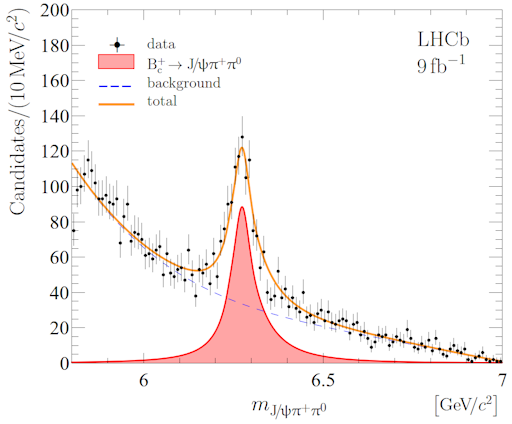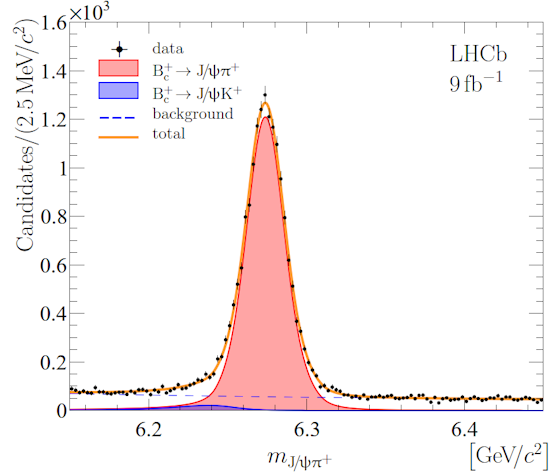The LHCb collaboration today submitted for publication a paper reporting the first observation of the Bc+→J/ψπ+π0 decay with overwhelming significance. The π+π0 mass spectrum is consistent with the dominance of an intermediate ρ+ contribution.
The Bc+ meson is composed of two heavy quarks, b and c. It is the heaviest meson that can only decay through the weak interactions via the decay of one heavy constituent, with the other quark playing the role of spectator. Its decay into charmonium and light quarks proceeds through the quark diagram shown in the image to the left. The decays of the Bc+ mesons into charmonium and odd-numbered light hadrons, such as Bc+→J/ψπ+, Bc+→J/ψK+, Bc+→ψ(2S)π+, Bc+→J/ψπ+π+π–, have been studied intensively and found to be in a remarkable agreement with the theoretical expectations. The Bc+→J/ψπ+π0 decay reported today is the simplest decay into charmonium and an even number of light hadrons. It has never been observed before.
From the theoretical point of view decays of Bc into J/ψ and even number of pions are closely related to the decays of the τ lepton into even number of pions and also to the e+e– annihilation into even number of pions. Precise measurements of e+e– annihilation into two pions in the ρ mass region (like in the Bc decay reported today) are crucial for the prediction of results from the Fermilab g-2 experiment in the framework of Standard Model. A precise measurement of the Bc+→J/ψπ+π0 decay will allow a better understanding of its possible contribution as a background source for the study of other decays of Bc mesons as well as rare decays of B0 mesons.
The top left image shows the J/ψπ+π0 mass spectrum, which is clearly clustered around the Bc+ mass. The π+π0 mass combination of pions from this decay clusters around the ρ meson mass as shown in the top right image.
The LHCb physicists measured the ratio of the branching fraction of the new decay to that of the Bc+→J/ψπ+, whose mass spectrum is shown in the image above on the left, and obtained a value of 2.80±0.15±0.11±0.16. The measured ratio has been calculated by various theorists over the last 30 years. Now these predictions can be compared with experimental measurements. The comparison of the LHCb result with these calculations is shown in the right-hand image above. Most of the predictions are confirmed by this new measurement.
The large b-quark production cross-section at the LHC and the excellent detector allows LHCb to study in detail the production, decays and other properties of the Bc+ meson. It is inteesting to note that 20 Bc+ decays have been observed so far (with more than 5 standard deviations) 18 of which were discovered by LHCb.
Read more in the LHCb paper and in the CERN news.





